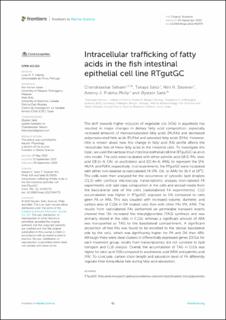| dc.description.abstract | The shift towards higher inclusion of vegetable oils (VOs) in aquafeeds has resulted in major changes in dietary fatty acid composition, especially increased amounts of monounsaturated fatty acids (MUFAs) and decreased polyunsaturated fatty acids (PUFAs) and saturated fatty acids (SFAs). However, little is known about how this change in fatty acid (FA) profile affects the intracellular fate of these fatty acids in the intestinal cells. To investigate this topic, we used the rainbow trout intestinal epithelial cell line (RTgutGC) as an in vitro model. The cells were incubated with either palmitic acid (16:0, PA), oleic acid (18:1n-9, OA), or arachidonic acid (20:4n-6, ARA), to represent the SFA, MUFA, and PUFA, respectively. In all experiments, the RTgutGC were incubated with either non-labeled or radiolabeled FA (PA, OA, or ARA) for 16 h at 190C. The cells were then analyzed for the occurrence of cytosolic lipid droplets (CLD) with confocal microscopy, transcriptomic analysis (non-labeled FA experiments) and lipid class composition in the cells and serosal media from the basolateral side of the cells (radiolabeled FA experiments). CLD accumulation was higher in RTgutGC exposed to OA compared to cells given PA or ARA. This was coupled with increased volume, diameter, and surface area of CLDs in OA treated cells than with other FAs (PA, ARA). The results from radiolabeled FAs performed on permeable transwell inserts showed that OA increased the triacylglycerides (TAG) synthesis and was primarily stored in the cells in CLDs; whereas a significant amount of ARA was transported as TAG to the basolateral compartment. A significant proportion of free FAs was found to be excreted to the serosal basolateral side by the cells, which was significantly higher for PA and OA than ARA. Although there were clear clusters in differentially expressed genes (DEGs) for each treatment group, results from transcriptomics did not correlate to lipid transport and CLD analysis. Overall, the accumulation of TAG in CLDs was higher for oleic acid (OA) compared to arachidonic acid (ARA) and palmitic acid (PA). To conclude, carbon chain length and saturation level of FA differently regulate their intracellular fate during fatty acid absorption. | en_US |
